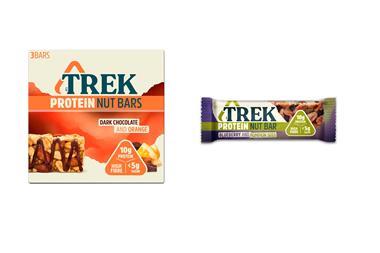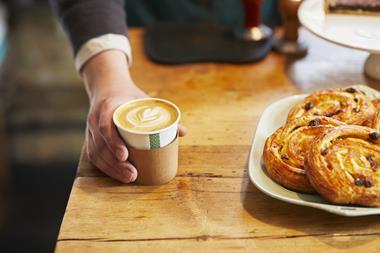Shoppers are thinking more about the ingredients in their food, and as a result snacks that tick the healthy box are growing in popularity
There is a strong demand for healthier snacks, with 70% of consumers agreeing that manufacturers should do more to reduce refined sugar in snacks.
And it’s important to get the snacking category right as 93% of adults take part in snacking, of which 63% do so once a day or more (Mintel consumer snacking, UK report – March 2017).
However, many retailers are failing to cater to this demand. A recent survey by Netmums and Sugarwise has revealed that 80% of parents regularly look for low- or no-sugar products for their families, yet 30% are unable to find these products in store. What’s more, Sugarwise – the international authority for sugar claims on foods – found that healthy lunchbox snacks were the most difficult items for parents to find in supermarkets (38%), followed by low-/no-sugar breakfast cereal (17%), low-/no-sugar pasta sauce (also 17%), and low-/no-sugar desserts (15%).
In case retailers needed any more encouragement to increase their offer, the Netmums survey also revealed 40% of participants agreed they would be happy to pay more for healthy options as long as the products tasted good.
Scott Graham, of McLeish Inverurie, in Aberdeenshire, is doing his best to meet this need. “There was a time when ‘health’ felt like a buzz word, like ‘gluten-free’, but both of these have become mainstream concerns which every demographic of customer is thinking about.
“The most important thing for us retailers to do is to provide our shoppers with choice. As long as we are providing our customers with a healthy alternative then we are doing our part.
“We are selling a lot of Whitworths fruit or nut Shots, which have the calories written on the front (only about 93 calories per pack) and they are really popular.
“Another popular range is Del Monte fruit tubs. They do pineapple chunks, melon chunks and fruit salad. The most popular is the Melon Medley. They cost £1 each and I get through nearly a case a day – six in a case.
“These products appeal to every type of customer, from the schoolchild, to the parent, to the workman.”
Exploding demand for popcorn
Cassandra Stavrou, co-founder of Propercorn, says health remains at the top of the agenda, but shoppers increasingly want reassurance beyond claims around calories and fat (Healthy Snacking & Tesco, Dunhumby, August 2017).
She says people are more conscious of naturalness and provenance, with 94% of households now buying into the Fairtrade market.
Propercorn’s latest addition, Perfectly Sweet, is the only Fairtrade-accredited popcorn on the market, made using quality unrefined, raw cane sugar. Available in both singles and sharing, Perfectly Sweet contains 130 kcals per serving, providing a sweet snacking solution for the Big Night In and a healthier alternative to traditional confectionery.
Propercorn is the number-one premium popcorn in the UK, the market-leader in single-serve popcorn, and fastest-growing within sharing (IRI Total Market Value Sales 52 w/e 22 July 2017).
Alongside the traditional healthy mainstays such as fruit and nuts, retailers have a huge opportunity to drive category sales by stocking a strong core range of healthier snacks that offer both convenience and an alternative to the more mainstream calorie-laden options. Snackers have fairly wide repertoires, with almost half (49%) eating five or more types of snacks (Mintel consumer snacking UK – March 2017) so variety is key.
Amanda Cook, founder of snacks supplier I Love Snacks, says shoppers are always on the lookout for ways to balance their diets. She adds: “In 2018 we’ll see the ‘balance equation’ become popular, with consumers finding creative ways to rationalise their snacking. It’s all about having a ‘little bit of what you fancy’, for example, something calorific and balancing this with healthier foods in other areas of the diet. “Ingredients, nutritional value, quality and provenance are all key motivations for customer purchases. Select brands that fulfil all four criteria.
“Not forgetting the rise in flexitarianism and the health-conscious consumer, having ‘free from’ options is a must.”
Scott adds that shoppers appear to think much more about the ingredients within products as people become more aware of intolerances and the importance of eating wholesome and natural foods.
“Some popular gluten-free cereal bars are the Trek flapjacks and the Kind bars,” he says.
Andrew Thornton, owner of Budgens Belsize Park in north London, says his free-from selection is also very popular.
“We are continuously developing our free-from offer as we are seeing a continuous positive response to these products and lots of npd within this category. People are becoming more aware of the positive impacts of having healthy diets and so any innovation in this sector tends to be well received.”
Ryvita creates Rye Cakes with higher fibre
Ryvita, the market share leader in crispbreads and flatbreads, added Rye Cakes (rrp £1.39) last year.
Unlike rice cakes, Ryvita Rye Cakes are significantly higher in fibre and a source of zinc and magnesium. They are also low in fat and contain 23 calories per cake.
Kyrsten Halley, head of brand at Ryvita, said: “The launch of Rye Cakes is the perfect showcase of how the Ryvita brand has evolved over the past few years, and provides consumers with a healthy option for any snacking occasion.”
Halley adds: “Rye Cakes will reinforce our core brand purpose, to empower everyone to discover and embrace the pleasure of positive health living, by delivering on taste and versatility, as well as the health benefits that come from the goodness of rye.”
Richard Inglis, director of Parkview Retail, with three Co-op Welcome stores in Southampton, says his shoppers are definitely health conscious and they think about much more than calories when trying to choose something that’s good for them. He explains: “Often it’s about gluten, wheat, sugar and other ingredients they are trying to cut down on.”
Debbie King, director of commercial sales & marketing at healthier snacking brand Eat Real, says free-from is predicted to be one of the biggest and fastest-growing food trends for 2018, with increased consumer demand for healthier snacking driving the sector like never before.
“Healthier snacking is undoubtedly the strongest trend in the snacks arena and we firmly believe that the preference for ‘good for you’ products will continue to outperform the market and drive further expansion of the sector.”
King points out, however, that the age of the consumer will influence how likely they are to follow this trend.
“We know that modern consumers, especially millennials, are seeking out snacks that don’t compromise on either taste or texture. They’re also more health-conscious and seeking out guilt-free snacks which align both with lifestyle choices and dietary considerations.”
Research by HIM Research & Consulting backs up King’s point about millennials. It found that the importance of health varies depending on the shopper’s age and where they live, and health is more important to millennials and to those from a higher socio-economic demographic.
And when thinking about how to appeal to millennials, retailers should also take note that in the age of social media, packaging or food that is ‘Instagrammable’ – meaning attractively presented and worthy of sharing online – will be popular in 2018 (Mintel’s 2018 Food and Drink Trends Report).
Another big trend for this age group is the Big Night In, and this mission is growing. King adds: “Sales of sharing bags have increased significantly in line with the growing popularity of all-day snacking and the Big Night In, a trend driven predominantly by health-conscious millennials and the Netflix generation.”
Shoppers set on reducing sugar intake
Clare Denham, head of category and market strategy at Danone Dairies UK & Ireland, says that there is an increasing desire for healthy choices when it comes to snacking, especially among millennial shoppers.
She adds that sugar reduction plays an important part in the discussion around healthier living. In fact, she points out that 92% of consumers are trying to actively reduce their sugar intake.
Art Delia, marketing director at Danone Dairies UK & Ireland, says brands such as Light & Free respond to this need. “Since launching in 2016, the brand has gone from strength to strength, with a 117% growth rate year on year.
“With its 0% fat and 0% added-sugar proposition, this Greek-style yogurt is the number one contributor to category growth within convenience and is proved to bring an incremental younger demographic into chilled yogurts and pot desserts.”
Delia adds that last year the company relaunched its new Activia 0% fat range with a no added sugar-recipe, supported by a heavyweight marketing campaign.
The range comes in six flavours: strawberry, peach, raspberry, vanilla, cherry and blueberry and is available in a four-pack format with an rrp of £1.99. “It is the fastest growing Activia sku within the convenience channel,” Delia adds.
The Activia range contains Bifidus ActiRegularis, proven to survive the passage through the entire gastro-intestinal tract.
The epitome of the Big Night In snack is popcorn, and this is a snack which has exploded in popularity thanks to shoppers’ perception of it as a low-calorie, light, high-fibre sweet or savoury snack which can replace crisps thanks to its single-bag format. Popcorn continues to be the fastest-growing category within snacking (IRI Value Sales 52 w/e 20 May 2017), with its unrivalled growth most recently driven by the Big Night In occasion. Sharing is of increasing importance, as 44% of UK adults plan quiet nights in, looking for sweet treats and formats suitable for at-home sharing. Kantar Worldpanel data shows that take-home sales have now passed the £100m mark for the first time, rising 14.6% on volumes up 7.5% (52 w/e 29 January 2017).
Steve Seddon, director at popcorn brand Jimmy’s UK, believes that companies will survive only if they strive to constantly find new ways of catering to health-conscious consumers. “Consumer demand for healthy snacking is growing at a rate that is three times faster than the traditional snacking category,” he says. Companies are needing to adapt to both market and consumer trends and establish a standout USP to help them shine above competitors in a hugely-populated market place. If this wasn’t challenging enough, the impending sugar tax and numerous consumer awareness campaigns have made the general public more clued-up about what goes into our food. In addition, the UK government have targeted a 20% reduction in sugary foods by 2020.”
Despite wanting healthy products, the nation also has a huge sweet tooth and taste is still paramount when choosing snacks. Many different sweeteners are available to achieve the sweet taste without the calories, but there are health concerns around these, too.
Seddon says it’s the natural sweeteners that win this battle: “As the sugar tax on fizzy drinks looms over the industry, natural sweeteners will be the future, and we are proactively searching for the best ways to satisfy our sweet tooth. Therefore, our product – a generous sized pack containing less than 100 calories combined with its standout taste and texture – takes some beating.
“The current momentum behind popcorn as an accessible snack, in part prompted by its perceived health benefits compared with other comparable snacks, has helped propel sales,” explains Caryn Gillan, director of category & insights at Bridgethorne.
“There is nothing to suggest that this approach to healthy eating is going to slow down and suppliers and retailers could further exploit this trend through the development of new formats and products.”
HIM points out that shoppers who value health as an important issue are just as likely to be on a treat mission as the average c-store shopper, therefore they are also likely to gravitate towards a treat item with added health benefits.
There are many new products to have tapped into this trend. OhsoGood Chocolate, for example, is a chocolate bar that’s free from gluten, wheat, nuts and dairy and delivers live bacteria more effectively than ordinary chocolate. The company says it allows shoppers to excuse the treat by focusing on the health benefits.
Julian Taylor-Green, of Spar Lindford, Hampshire, has noticed that shoppers are always looking for an excuse and a justification to snack. “Snacking is huge and people will look for any justification they can to allow themselves to have a snack, whether that be because the bar says ‘protein’ on the front, or whether it’s in healthy-looking packaging, these products give them an excuse to snack.”
Julian adds that anyone who sells a lot of coffee to go is likely to sell a lot of snacks. He thinks 80-90% of his shoppers who buy a coffee also buy a snack. Therefore it makes sense to merchandise these healthier options beside the coffee machine.
Cook, at I Love Snacks, says healthy snacking products need to be the first items that a customer discovers in store.
“With convenience stores, busy shoppers on the go make snap decisions. You cannot have a small offering in a corner that consumers need to search for. If you are limited on space, ensure clear signposting and stock attractively packaged, convenient gym bag- or handbag -sized snacks.”
Cassandra Stavrou, co-founder of Propercorn, says snacking fixtures within stores need to reflect the growing health trend in order to stay relevant to the modern, health-conscious shopper. She says retailers should present their shoppers with a range of healthier snacking alternatives and be confident to make space previously owned by more traditional snacking favourites such as crisps and add in healthier options, such as popcorn.
As King, from Eat Real, sums up: “Healthier snacking is here to stay and that can only mean that there will be some great opportunities for c-store operators to tap into.”



























No comments yet